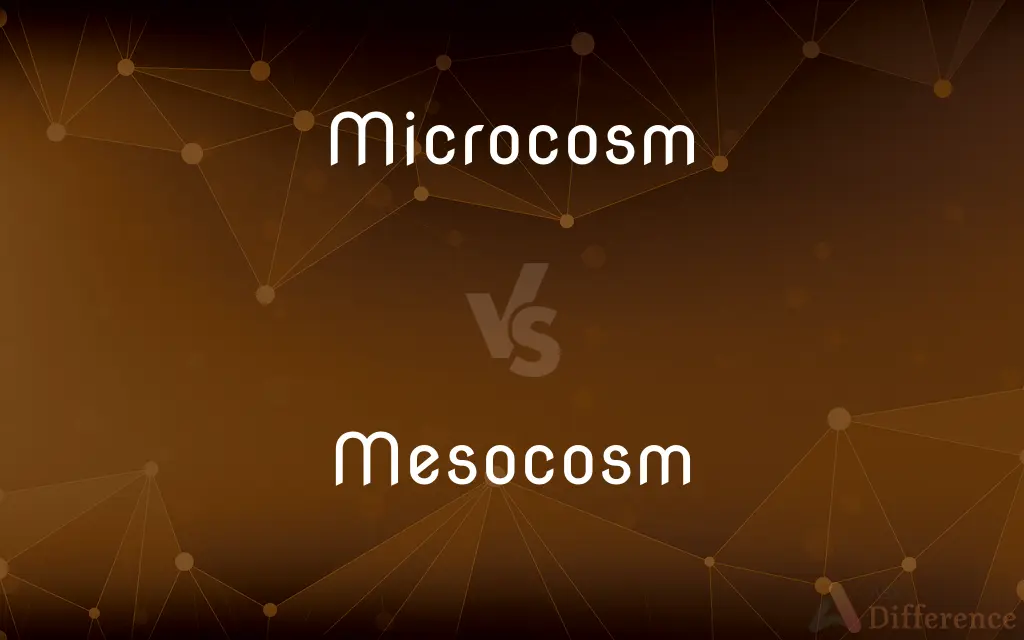Microcosm vs. Mesocosm — What's the Difference?
By Maham Liaqat & Fiza Rafique — Updated on March 25, 2024
Microcosm represents a smaller system viewed as a representation of a larger one, while mesocosm is an intermediate-sized controlled environment used for ecological research.

Difference Between Microcosm and Mesocosm
Table of Contents
ADVERTISEMENT
Key Differences
A microcosm is often used metaphorically and scientifically to denote a small, manageable system that reflects the characteristics, behaviors, or functions of a larger system. On the other hand, a mesocosm serves as a bridge between small-scale laboratory experiments (microcosms) and large-scale natural environments or ecosystems.
Microcosms are utilized across various disciplines, including biology, ecology, sociology, and even literature, to illustrate how parts of a system can represent the whole. For example, a single leaf can be a microcosm of an entire ecosystem, embodying the broader ecological interactions within its structure. Mesocosms, however, are specifically designed for ecological and environmental studies, providing a semi-natural setting where researchers can experiment with biotic and abiotic factors to observe their effects on organisms or ecosystems without the full-scale unpredictability of natural environments.
In the context of ecological research, microcosms tend to be simpler, often laboratory-based systems that can be used to study fundamental biological processes or interactions in a highly controlled environment. They offer precision in manipulation and measurement but at the cost of reduced ecological complexity and realism. Mesocosms, with their larger size and outdoor setting, afford a greater degree of ecological relevance and complexity, allowing for more comprehensive studies of ecological dynamics, including the impacts of environmental changes, pollution, or species interactions.
The scale and control level differentiate a microcosm from a mesocosm. While microcosms provide a high degree of control and are ideal for isolating specific variables or processes, mesocosms balance control with natural variability, offering insights that are more applicable to real-world conditions. This balance makes mesocosms particularly valuable for applied research, such as testing the ecological effects of pollutants, understanding the impacts of climate change, or developing conservation strategies.
Both microcosms and mesocosms play crucial roles in ecological and environmental sciences, offering complementary approaches to studying complex systems. By enabling detailed observation and experimentation at different scales and levels of complexity, they contribute significantly to our understanding of ecological processes and our ability to address environmental challenges.
ADVERTISEMENT
Comparison Chart
Scale
Small, often laboratory-based
Intermediate, larger than lab experiments but smaller than natural environments
Purpose
To reflect or represent larger systems in a simplified manner
To study ecological processes under semi-controlled conditions
Use in Research
Broad, including non-ecological fields
Primarily ecological and environmental sciences
Level of Control
High control over variables
Balance between control and natural variability
Realism
Less ecological complexity, more simplified
Greater ecological relevance and complexity
Application Examples
Studying basic biological processes, societal models
Examining the effects of pollutants, climate change impacts
Compare with Definitions
Microcosm
Ideal for isolating and studying particular processes.
Microcosms help in understanding nutrient cycling on a small scale.
Mesocosm
Enables realistic ecological interaction studies.
Mesocosms simulate realistic predator-prey dynamics.
Microcosm
Used across disciplines to simplify complex systems.
A classroom is a microcosm of society.
Mesocosm
Provides semi-controlled outdoor settings.
Researchers use mesocosms to examine the effects of pollutants on coral reefs.
Microcosm
A small system that represents a larger whole.
A terrarium acts as a microcosm of a rainforest ecosystem.
Mesocosm
Bridges laboratory experiments and natural conditions.
A mesocosm allows for the controlled study of aquatic plants.
Microcosm
Offers high control for experimental study.
Using a microcosm, scientists can precisely manipulate environmental conditions.
Mesocosm
An intermediate-sized environment for ecological research.
Mesocosms are used to study wetland ecosystems.
Microcosm
Highlights specific characteristics of a larger system.
A single family can be a microcosm of broader cultural dynamics.
Mesocosm
Applied in studying environmental change impacts.
Mesocosms help predict ecosystem responses to global warming.
Microcosm
A small, representative system having analogies to a larger system in constitution, configuration, or development
"He sees the auto industry as a microcosm of the U.S. itself" (William J. Hampton).
Mesocosm
A mesocosm (meso- or 'medium' and -cosm 'world') is any outdoor experimental system that examines the natural environment under controlled conditions. In this way mesocosm studies provide a link between field surveys and highly controlled laboratory experiments.Mesocosms tend to be medium-sized to large (e.g., aquatic mesocosm range: 1 litre (34 US fl oz) to 10,000 litres (2,600 US gal)+) and contain multiple trophic levels of interacting organisms.
Microcosm
Human nature or the human body as representative of the wider universe; man considered as a miniature counterpart of divine or universal nature.
Mesocosm
A biological system that contains the physical features and organisms of an ecosystem but is restricted in size or scope for use in conducting scientific experiments.
Microcosm
(obsolete) The human body; a person.
Mesocosm
Any system larger than a microcosm but smaller than a macrocosm, especially when used as an outdoor experimental system that examines the natural environment under controlled conditions.
Microcosm
A smaller system which is seen as representative of a larger one.
Microcosm
(ecology) A small natural ecosystem; an artificial ecosystem set up as an experimental model.
Microcosm
A little world; a miniature universe. Hence (so called by Paracelsus), a man, as a supposed epitome of the exterior universe or great world. Opposed to macrocosm.
Microcosm
A relatively small object or system considered as representative of a larger system of which it is part, exhibiting many features of the complete system.
Microcosm
A miniature model of something
Common Curiosities
How do advancements in technology impact microcosm and mesocosm research?
Technological advancements have enhanced the precision, control, and monitoring of conditions within microcosms and mesocosms, allowing for more detailed and accurate data collection and analysis, thereby improving the reliability of research outcomes.
Can microcosms and mesocosms help in conservation efforts?
Yes, they can provide valuable insights into ecological processes and species requirements, helping in the development of more effective conservation strategies and restoration practices by testing them under controlled conditions before wide-scale implementation.
What is the future of microcosm and mesocosm research in addressing global environmental changes?
They are poised to play a crucial role in predicting and mitigating the impacts of global environmental changes by allowing scientists to experiment with and model ecosystem responses to variables such as temperature rises, pollution, and species extinction in a controlled yet realistic manner.
What role do microcosms and mesocosms play in understanding biodiversity?
They are instrumental in studying biodiversity by simulating various environmental conditions and interactions, allowing scientists to observe the effects of changes in habitat, climate, or species introductions on biodiversity within controlled settings.
How do microcosms contribute to educational purposes?
Microcosms offer a tangible, interactive way to teach complex ecological and biological concepts, allowing students to observe the dynamics of ecosystems and the interdependence of organisms in a simplified, accessible manner.
What are the challenges of using mesocosms in research?
Challenges include ensuring the mesocosm accurately simulates the natural environment, managing external variables that could influence results, and the cost and space requirements to set up and maintain these systems.
Can a mesocosm be used for non-ecological studies?
Primarily, mesocosms are designed for ecological and environmental research due to their size and the ability to manipulate ecological processes.
Why are microcosms important in research?
Microcosms allow researchers to isolate and study specific processes or interactions within a highly controlled environment, providing insights into the functioning of larger systems.
What is a microcosm?
A microcosm is a small-scale system that mirrors or represents the characteristics of a larger system, used for simplifying and studying complex dynamics.
How does a mesocosm differ from a microcosm?
A mesocosm is an intermediate-sized controlled environment that allows for ecological research with a balance of natural conditions and experimental control, unlike the smaller, more simplified microcosm.
What makes mesocosms special in ecological studies?
Mesocosms provide a semi-natural environment that bridges the gap between laboratory experiments and real-world ecosystems, enabling studies that are more applicable to natural conditions.
How do researchers decide between using a microcosm or a mesocosm?
The choice depends on the research objectives, the need for control versus realism, and the specific ecological processes or interactions being studied.
Are there limitations to using microcosms and mesocosms?
Yes, microcosms may lack ecological complexity and realism, while mesocosms, though more realistic, still cannot fully replicate the unpredictability and full scale of natural ecosystems.
Share Your Discovery

Previous Comparison
Bharat vs. Hindustan
Next Comparison
Dona vs. DonnaAuthor Spotlight
Written by
Maham LiaqatCo-written by
Fiza RafiqueFiza Rafique is a skilled content writer at AskDifference.com, where she meticulously refines and enhances written pieces. Drawing from her vast editorial expertise, Fiza ensures clarity, accuracy, and precision in every article. Passionate about language, she continually seeks to elevate the quality of content for readers worldwide.
















































